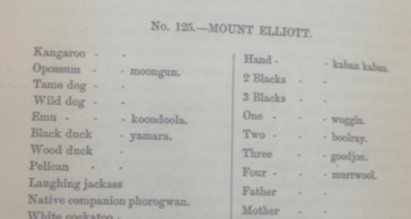the Yangga language
Words, insights and more!
Early Sources
HOW TO READ EARLY SOURCES
WHAT ARE EARLY SOURCES?
Much of Yangga has been taken away from present generations, and we can only rely on what has been written by people who came to Jangga lands in earlier centuries. Some of these people wrote lists of words in the Yangga language, and sometimes these words are the main way we have now of knowing what Yangga was like.
WHAT DO THEY LOOK LIKE?
They are mostly typed or handwritten word lists.

Anon. (1886)
BENEFITS OF EARLY SOURCES
Early sources are good sources of knowledge of words which have otherwise been lost.
PROBLEMS OF EARLY SOURCES
Sometimes the early sources had no real knowledge of Yangga so they didn’t understand much of what they were writing down:
- Sometimes they misunderstood some words, and got the meanings wrong.
- Sometimes they didn’t hear the words properly and didn’t understand the language so they spelt the words incorrectly.
- Sometimes they only wrote down words. Words are great, but they are only one part of a language as a whole system of communication.
- They usually didn’t write the language name down, only a location, so often we have to guess or work out what language a word list comes from.
- They often didn’t understand the people they were asking, so they often wrote the wrong locations to the word lists.
- They didn’t realise how multilingual people were, so they didn’t know that one specific locaton may be associated with more than one language.
TRANSLATIONS: ALIEN INVASION
Imagine an alien landed on earth, found the first person they saw, pointed to a hundred things, and asked the person what was the term for each one. Imagine they pointed to a particular bird. The person could answer any one of the following, and be correct:
- bird
- magpie
- flying
- standing
- black and white
- hungry
- walking
- near the water
- uphill
- etc. etc.
So when we read a word in a word list, we don’t always know that the translation is correct.
LOCATIONS
Locations given are not always accurate either:
- Sometimes they can be very general and cover a range of possible languages.
- Sometimes it is not easy to know what the location refers to. For example, if the alien asked where this person they found was from, they could say:
- Australia
- the city they were born in
- the suburb they live in now
- the place their mother or father is from
All these places are correct and true and good answers to the question, but they do not always lead to the correct identification of a language.
SPELLING
The Yangga language at that time did not have a spelling system or a way of being written down. It is really difficult to spell Yangga if you only know English. This is because Yangga has sounds in it which do not occur in English.
So how did the early sources write Yangga words? The answer is, not very reliably or consistently. for example:
take the word for ‘rain’. In different sources we have:
- durgun Anon (1886)
- komoo M. Curr (1886)
- kamo Kent (1886)
- kamu Tindale (1938)
How can we understand these?
It looks like durgun is a different word. But kamo and komoo and gamu look similar. Probably komoo, kamo and kamu all refer to the same Yangga word, but just spelt differently:
If you say each word out loud, it sounds more or less the same – this sounds probably similar to the Yangga word the early sources were aiming to write down. It is not that there are three different words. There is one Yangga word, but spelt in different ways.
CAN WE USE EARLY SOURCES THEN?
We can use the information contained in early sources, but we have to be careful.
One way to be more sure is to compare as many different early sources as we can. So for the words for ’rain/water’, if three early sources have a word like gummoo, then we can make a guess that the Yangga word was probably something like gummoo. We can do this with many word lists where the same word appears again and again in different lists. Another word is for ‘emu’:
COMPARING LOTS OF FORMS FOR THE SAME THING
‘emu’:
- koondoola (Anon 1886)
- koondooloo (M. Curr 1886)
- goondooloo (Kent 1886)
- kundulu (Tindale 1938)
CONCLUSION
The early sources are very useful for early information on Yangga, but they need to be treated with caution, as they do not always reflect a good knowledge of Yangga or the correct way to spell the language.
SOURCES (POSSIBLY YANGGA)
- Curr, Montagu (1886) ‘Porter’s Range’, in Curr, E.M. (1886–87) Australian Race vol 2: 456 & 457.
- Tindale, Norman B. (1938) ‘Australian Vocabularies gathered by Norman B. Tindale, 1938-1963’ Ms. held at the South Australian Museum MS AA 338/8/20, and AIATSIS MS 3189.
- Kent, W. H. (1886) ‘Ravenswood, Upper Burdekin’ in Curr, E.M. (1886-87) The Australian Race vol 2: 484-485.
- Barnett, Jas.R. (1891) ‘The Aboriginal Language’ [letter to the editor],The Queenslander, April 11, 1891:703.
SOURCES (PROBABLY NOT YANGGA)
- Anonymous (1886) ‘Mount Elliott’, in Curr, EM (1886–87) The Australian Race vol 2: 452–453.
- Muirhead, James and Charles Lowe (1886) ‘Belyando River’ in Curr, E.M. (1886–87) The Australian Race vol 3: 26–35.
Dr. Angela Terrill, Linguist